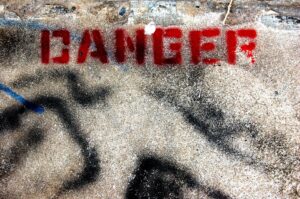With climate change high on the political agenda and natural disasters a regular occurrence, impacting populations around the world, we look at how IoT and AI are providing solutions and support in dangerous situations.
In 110 AD, an earthquake is believed to have hit the Dian Kingdom in China, likely killing thousands without warning.
Around 20 years later, a scholar named Zhang Heng developed an ornate device designed to monitor movements in the earth. This early seismograph resembled a bronze vase, with eight dragons’ heads mounted on the outside, one for each of the main compass points. Each of the creatures had a ball in its mouth, which would be dislodged if shockwaves were detected, indicating the direction from which the seismic activity had occurred.
 While the instrument could only notify observers of earthquakes that had already happened, in a time when sending messages could take weeks, it could still help when it came to sending assistance as swiftly as possible. Indeed, a few years later, one of the dragon’s balls dropped and a few days later a messenger arrived with news of a quake several hundred miles to the west – exactly as the detector had indicated.
While the instrument could only notify observers of earthquakes that had already happened, in a time when sending messages could take weeks, it could still help when it came to sending assistance as swiftly as possible. Indeed, a few years later, one of the dragon’s balls dropped and a few days later a messenger arrived with news of a quake several hundred miles to the west – exactly as the detector had indicated.
“Nearly 2000 years on and even the most advanced early warning systems can only give a few seconds notice of an impending earthquake, but advances in the internet of things (IoT) mean we don’t have to rely on decorative dragons anymore.”
At fault
The state of California is no stranger to earthquakes. It has a history of devastating tremors, with a 6+ magnitude pair in July responsible for buckled highways and damaged gas lines – but a recently launched early warning system could help to save lives in the event of another ‘Big One’ striking a major city and wreaking havoc.
SkyAlert is an IoT-based early warning system that is soon to launch in California, Oregon and Washington, but has been active in Mexico for a number of years, where it has around six million users. It uses a network of seismometers embedded in the walls of buildings to measure tectonic activity throughout the region. These sensors are connected by fibre-optic cables and only buildings with emergency back-up power are chosen to ensure there are no dropouts in connectivity.
 When seismic motion is detected, a cloud-based platform sends notifications to users’ smartphones and wearables and activates standalone warning devices installed at schools and businesses in at-risk areas. Alerts are colour-coded depending on the intensity of the earthquake, with louder alarm sounds for more serious tremors. People who only respond to a quake when the shaking starts are likely to waste precious time working out what to do, which could increase their chance of injury or death, but SkyAlert can warn people up to two minutes before it strikes – 40 seconds sooner than other systems.
When seismic motion is detected, a cloud-based platform sends notifications to users’ smartphones and wearables and activates standalone warning devices installed at schools and businesses in at-risk areas. Alerts are colour-coded depending on the intensity of the earthquake, with louder alarm sounds for more serious tremors. People who only respond to a quake when the shaking starts are likely to waste precious time working out what to do, which could increase their chance of injury or death, but SkyAlert can warn people up to two minutes before it strikes – 40 seconds sooner than other systems.
The system’s work isn’t done when the shaking stops either. Its standalone warning devices are based on Raspberry Pi computers and include accelerometers, plus Zigbee modules that are capable of detecting the presence of smoke and natural gas, so an initial assessment of the damage to the building can be made remotely. Users can also use the app to ask for help in the aftermath of a disaster, with a live emergency chat room allowing them to communicate effectively with help.
“The sensors can also be used to monitor temperature, humidity, and air pressure, so this kind of technology can also warn of incoming hurricanes, tornadoes and other destructive weather events.”
 Sensors on trees can also measure temperature, moisture, CO and CO2 levels, which can help to predict which areas could be susceptible to forest fires in particularly hot and dry periods.
Sensors on trees can also measure temperature, moisture, CO and CO2 levels, which can help to predict which areas could be susceptible to forest fires in particularly hot and dry periods.
Prevention is better than cure
Technology cannot prevent disasters from occurring but it can help us to be better prepared in the event of a catastrophe. Companies such as One Concern use machine learning to identify and quantify the likely impact of natural disasters on particular neighbourhoods, helping to build long-term resilience, while IoT devices can be used to monitor the integrity of buildings, bridges and other parts of the infrastructure, alerting local authorities in advance when attention is needed and warning if structures are deemed unlikely to withstand any predicted extreme weather.
“IoT tech can also help to coordinate the emergency response and improve planning and communication between first responders.”
BlueLine Grid, for example, was set up by a former NYPD commissioner in 2014. A mobile communications platform that connects all users to a network of first responders, law enforcement officials and security staff, enabling the efficient use of voice, text and location services in the relief effort.
 Even social media can play an important role. As well as Facebook’s ‘mark yourself safe’ feature, which is activated for users in particular locations after life-changing events, and chatbots to provide information to survivors far quicker than humans could, artificial intelligence (AI) can be used to analyse posts for cries for help. After the devastating 7.8 magnitude earthquake in Nepal in 2015, volunteers quickly assembled thanks to tags in related photos and tweets, with AI then used to analyse the posts and identify which areas had the most urgent need for resources and assistance.
Even social media can play an important role. As well as Facebook’s ‘mark yourself safe’ feature, which is activated for users in particular locations after life-changing events, and chatbots to provide information to survivors far quicker than humans could, artificial intelligence (AI) can be used to analyse posts for cries for help. After the devastating 7.8 magnitude earthquake in Nepal in 2015, volunteers quickly assembled thanks to tags in related photos and tweets, with AI then used to analyse the posts and identify which areas had the most urgent need for resources and assistance.
Evidently, we’ve come a long way since Zhang Heng’s 2000-year-old ball-based detection device, but there’s a part of its design that turned out to be particularly relevant. When a ball was dislodged from a dragon’s jaws it landed in the mouth of a bronze toad, while in 2010 a colony of the pond dwellers was observed unexpectedly abandoning its home five days before a quake hit less than 50 miles away. Coincidence? Maybe. Or perhaps the amphibious animals offer a surprisingly prescient early warning system when it comes to earthquake detection.
The potential benefits that IoT might bring are yet to be truly realised. Countries like India are paving the way, heavily investing in technology to create 100 smart cities by the year 2020. With an integrated tech infrastructure, India is developing an entire smart ecosystem able to monitor and adapt to the needs of its inhabitants in countless ways.
“Innovations in IoT will not only help to alert us to dangers around natural disaster, but consistently survey our environment to signal risk, such as exposure to pollution or resource shortages.”
With the ability to continuously evolve and build on this, we can harness the power to improve standards of living, raise health and ultimately save lives.
Read more about the potential of IoT in India.
Transformational Hybrid SolutionsOur cloud-enablement services offer the best performance on your traffic-heavy websites or mission-critical applications.
Core NetworksTata Communications™ global IT infrastructure and fibre network delivers the resources you need, when and where you need them.
Network Resources
Unified Communications As A ServiceBreak the barriers of borders efficiently and increase productivity with Tata Communications’ UC&C solutions.
Global SIP ConnectEmpower your business with our SIP network and witness it grow exponentially.
InstaCC™ - Contact Centre As A ServiceCloud contact centre solutions for digital customers experience and agent productivity.
DIGO – Communications Platform as a ServiceDIGO is an in-network cloud communications platform, enabling you to power up converged contextual human-to-everything conversations globally.
Unified Communication Resources Case studies, industry papers and other interesting content to help you explore our unified communications solution better.
IoT SolutionsThe Internet of Things is transforming the way we experience the world around us for good. Find out more about our Internet Of Things related solutions here.
Mobility SolutionsTata Communications’ mobility services enable your enterprise to maintain seamless communication across borders, with complete visibility of cost and usage.
Mobility & IoT Resources
Multi-Cloud SolutionsWith enterprises transitioning to a hybrid multi-cloud infrastructure, getting the right deployment model that yields ROI can be a daunting task.
Cloud ComplianceCompliant with data privacy standards across different countries and is also designed to protect customers’ privacy at all levels.
IZO™ Cloud Platform & ServicesIZO™ is a flexible, one-stop cloud enablement platform designed to help you navigate complexity for more agile business performance.
Managed Infrastructure ServicesIntegrated with our integrated Tier-1 network to help your business grow efficiently across borders.
Cloud PartnersWe support a global ecosystem for seamless, secure connectivity to multiple solutions through a single provider.
Cloud Resources
Governance, Risk, and ComplianceRisk and Threat management services to reduce security thefts across your business and improve overall efficiencies and costs.
Cloud SecurityBest-in-class security by our global secure web gateway helps provide visibility and control of users inside and outside the office.
Threat Management - SOCIndustry-leading threat-management service to minimise risk, with an efficient global solution against emerging security breaches and attacks.
Advanced Network SecurityManaged security services for a predictive and proactive range of solutions, driving visibility and context to prevent attacks.
Cyber Security ResourcesCase studies, industry papers and other interesting content to help you explore our securtiy solution better.
Hosted & Managed ServicesTata Communications provide new models for efficient wholesale carrier voice service management. With our managed hosting services make your voice business more efficient and better protected
Wholesale Voice Transport & Termination ServicesYour long-distance international voice traffic is in good hands. End-to-end, voice access & carrier services which includes voice transport and termination with a trusted, global partner.
Voice Access ServicesTata Communication’s provide solutions which take care of your carrier & voice services, from conferencing to call centre or business support applications.
Carrier Services Resources
CDN Acceleration ServicesOur CDN Web Site Acceleration (WSA) solution helps deliver static and dynamic content, guaranteeing higher performance for your website.
CDN SecuritySafeguard your website data and customers’ information by securing your website from hacks and other mala fide cyber activities.
Video CDNDeliver high-quality video content to your customers across platforms – website, app and OTT delivery.
CDN Resources
Elevate CXIncrease customer satisfaction while empowering your service team to deliver world-class customer experience and engagement.
Live Event ServicesTata Communications’ live event services help battle the share if eyeballs as on-demand video drives an explosion of diverse content available on tap for a global audience.
Media Cloud Infrastructure ServicesTata Communications’ media cloud infrastructure offers flexible storage & compute services to build custom media applications.
Global Media NetworkTata Communications’ global media network combines our expertise as a global tier-1 connectivity provider with our end-to-end media ecosystem.
Use CasesUse cases of Tata Communications’ Media Entertainment Services
Remote Production SolutionsMedia contribution, preparation and distribution are highly capital-intensive for producers of live TV and video content, and their workflows are complex.
Media Cloud Ecosystem SolutionsThe Tata Communications media cloud infrastructure services offer the basic building blocks for a cloud infrastructure-as-a-service.
Global Contribution & Distribution SolutionsTata Communications’ global contribution and distribution solution is built to reduce capital outlay and grow global footprint.
Satellite Alternative SolutionsAs more and more consumers choose to cut the cord & switch to internet-based entertainment options, broadcasters are faced with capital allocation decisions.
LeadershipA look into the pillars of Tata communications who carry the torch and are living embodiment of Tata’s values and ethos.
Culture & DiversityHere at Tata Communications we are committed to creating a culture of openness, curiosity and learning. We also believe in driving an extra mile to recognize new talent and cultivate skills.
OfficesA list of Tata Communications office locations worldwide.
SustainabilityTata Communications adopts a holistic approach and harnesses the power of new-age technologies like 5G, IoT and AI to build a sustainable digital world.
FAQCheck out our FAQs section for more information.
BoardHave a look at our board of members.
ResultsFind out more about our quarterly results.
Investor PresentationsFollow our repository of investor presentations.
FilingsGet all information regarding filings of Tata communications in one place.
Investor EventsAll investor related event schedule and information at one place.
GovernanceAt Tata, we believe in following our corporate social responsibility which is why we have set up a team for corporate governance.
SharesGet a better understanding of our shares, dividends etc.
SupportGet all investor related contact information here.



